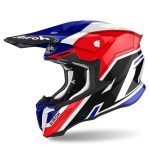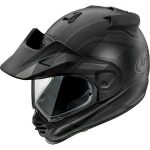Ever been cruising down the highway, enjoying the scenery, only to have your visor fog up and obstruct your vision? It’s a frustrating and potentially dangerous situation. Fogging is a common problem for motorcycle riders, especially in cold or humid weather. But fear not, fellow bikers! There are several effective ways to prevent your helmet visor from fogging up, keeping your vision clear and your ride safe.
Why Does My Motorcycle Helmet Visor Fog Up?
Before diving into solutions, let’s understand the science behind the fog. Fogging occurs when warm, moist air (your breath) condenses on the cooler surface of your visor. This creates tiny water droplets that obstruct your vision, similar to how a bathroom mirror fogs up after a hot shower.
Here are some factors that contribute to helmet visor fogging:

- Temperature difference: The bigger the difference between your breath’s temperature and the visor’s temperature, the faster fogging will occur. Cold weather and high humidity exacerbate the problem.
- Ventilation: Poor airflow inside your helmet traps moisture, leading to fogging.
- Moisture source: Sweating or using a damp balaclava can increase the amount of moisture inside your helmet.
Conquer the Fog: Top Strategies for a Clear Visor
Now that we know the enemy, let’s explore the best ways to prevent fogging and ensure a clear view on your rides:
1. Embrace Ventilation: Let the Fresh Air Flow
- Open the vents: Most helmets come equipped with vents on the chin, forehead, and top. Open these vents before you start riding to encourage airflow and prevent moisture buildup.
- Crack open the visor: A slightly open visor creates airflow across the inner surface, helping to evaporate moisture and prevent fogging. However, be mindful of wind noise and cold air at higher speeds.
2. Invest in Anti-Fog Solutions: Tech to the Rescue
- Anti-fog sprays and wipes: These readily available products create a hydrophobic (water-repellent) layer on your visor, preventing moisture droplets from forming. Apply them according to the manufacturer’s instructions, typically cleaning the visor first and then applying a thin, even coat. Remember, these treatments are temporary and may need to be reapplied throughout the day.
- Pinlock visor inserts: These innovative inserts attach to the inside of your visor, creating a double-glazed effect. The trapped air layer acts as an insulator, minimizing the temperature difference and preventing fogging. Pinlock inserts are a permanent solution for many riders and offer excellent anti-fogging performance.
3. Manage Moisture: Keep it Dry Inside
- Moisture-wicking balaclava: A good-quality balaclava made from a moisture-wicking material like polyester will absorb sweat and prevent it from evaporating inside your helmet. This reduces the overall moisture level and helps prevent fogging.
- Avoid bringing extra moisture inside: Don’t wear a wet scarf or balaclava under your helmet. Let them dry completely before your ride.

4. Explore Visor Technology: Upgrade Your Gear
- Anti-fog coated visors: Many helmet manufacturers offer visors with a permanent anti-fog coating applied during production. These visors offer long-lasting fog prevention without the need for additional treatments.
- Dual-shield visors: Some high-end helmets feature a dual-shield system with a built-in, permanently pinlock-like insert. This offers superior fog prevention and eliminates the need for separate inserts.
5. Bonus Tip: DIY Defogging Techniques (Use at your own risk)
- Shaving cream: Apply a thin layer of shaving cream to the inside of your visor, let it dry to a haze, and then buff it off with a microfiber cloth. This leaves a temporary anti-fogging film. However, be aware that some shaving creams can damage the visor’s anti-scratch coating, so test it on a small area first.
- Soap: Apply a thin layer of bar soap to the inside of your visor and buff it off with a microfiber cloth. Similar to shaving cream, this offers temporary fog prevention, but exercise caution as soap can also damage the visor’s coating.
Always follow the manufacturer’s instructions for cleaning and maintaining your motorcycle helmet visor. Harsh chemicals or abrasive cleaners can damage the anti-fog coating or scratch the visor, reducing its effectiveness.
Don’t Let Fog Ruin Your Ride: Choose the Right Solution for You
The best solution for preventing fogging in your motorcycle helmet depends on your riding style, budget, and personal preferences. Experiment with different techniques and products to find what works best for you. Here’s a quick breakdown to help you decide:

- Ventilation and moisture management: This is a simple and cost-effective approach. Open the vents on your motorcycle helmet, crack open the visor slightly when conditions allow, and wear a moisture-wicking balaclava.
For frequent riders who want a long-lasting solution:
- Anti-fog spray and wipes: These are a convenient and affordable option, but require frequent reapplication.
- Pinlock visor inserts: These offer excellent fog prevention and are a more permanent solution than sprays.
For riders who prioritize ultimate fog prevention and don’t mind investing:
- Anti-fog coated visors: These eliminate the need for additional treatments and provide long-lasting protection.
- Dual-shield visors: These high-end visors offer the best fog prevention available, but come at a premium price.
Fog-Free Riding Starts Here!
Now that you’re armed with the knowledge and strategies to combat motorcycle helmet visor fogging, you can enjoy clear vision and safe rides in any weather condition. Remember, a clear visor is essential for safe riding. Don’t let fog cloud your judgment and compromise your safety. Invest in a solution that works for you and keep your focus on the road ahead.
Maintaining Clarity: Caring for Your Anti-Fog Solution
No matter which anti-fog solution you choose, proper care and maintenance are crucial for optimal performance. Here are some tips to ensure your visor stays fog-free for longer:

- Cleaning is Key: Regularly clean your visor with a mild, non-abrasive cleaner and a microfiber cloth. Dirt, grime, and oils can reduce the effectiveness of anti-fog treatments.
- Avoid Harsh Chemicals: Steer clear of harsh chemicals, ammonia-based cleaners, or abrasive cloths, as these can damage the visor’s anti-fog coating or scratch the surface.
- Store it Right: When not in use, store your motorcycle helmet in a cool, dry place away from direct sunlight. Excessive heat can damage the visor’s anti-fog properties.
- Replace When Needed: Anti-fog sprays and wipes have a limited lifespan. Replace them when they become less effective. Pinlock inserts may also need to be replaced periodically if they become scratched or worn.
Beyond Fog: Additional Visor Care Tips
For optimal visor performance and a safe riding experience, here are some additional care tips:

- Scratch Prevention: Invest in a motorcycle helmet visor sleeve to protect your visor from scratches during storage or transport. Scratches can not only hinder visibility but also weaken the visor, making it more susceptible to cracking.
- Regular Inspections: Periodically inspect your visor for cracks, scratches, or other damage. A damaged visor can compromise your safety and should be replaced immediately.
- Cleaning After Every Ride: Make cleaning your visor a part of your post-ride routine. This removes dirt, dust, and insect splatter, improving visibility and overall helmet hygiene.
By following these simple yet effective strategies, you can keep your motorcycle helmet visor fog-free and ensure a clear view on every ride. Remember, a clear visor is not just a comfort factor; it’s a crucial element for safe motorcycle riding. Invest in an anti-fog solution that suits your needs, maintain your visor properly, and enjoy the freedom of the open road with uninterrupted visibility.


